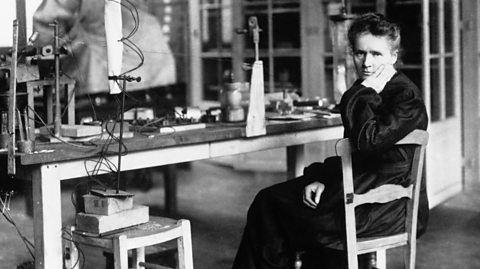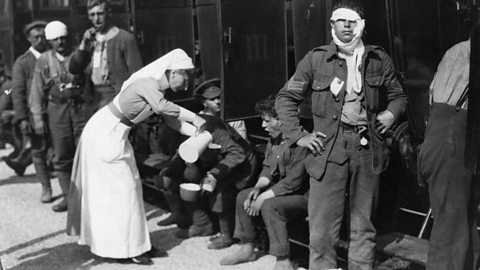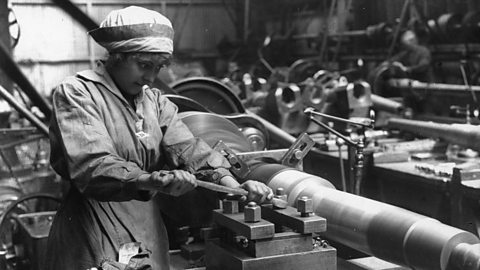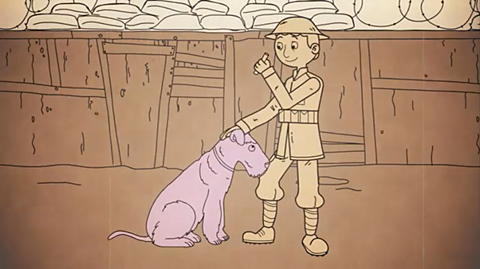What was it like for women?

Women were not allowed to fight as soldiers in World War One. So they found other ways to help on the front line.
- It was dangerous for women travelling to the war zones. They were at risk from enemy fire.
- Some women worked as nurses and some mended cars.
- They worked long hours. They slept on uncomfortable camp beds and had to be up early for duty.
- Women on the front line were very brave.

What did the Women’s Army Auxiliary Corps do?
The WAAC began in 1917 as the Army was running short of men.

Image caption, Volunteers joined the Women's Army Auxiliary Corps (WAAC)
They wore green or 'khaki' uniforms: a small cap, jacket and skirt. They exercised every day, taking part in Morris dancing and hockey to keep fit. The WAAC was later known as later known as Queen Mary's Army Auxiliary Corps.
Image caption, Women cooked for men in camps and hospitals
Meals included savoury rice, sea pie, duff pudding, plus food which is more familiar to us today such as stew and even curry! The food was often better quality than men had back home.
Image caption, Women took administrative tasks in the war offices
They received 24 shillings for unskilled work but up to 48 shillings for jobs with specific skills like shorthand or typing. They also answered telephones and passed messages to soldiers.
Image caption, Women repaired motor vehicles which had broken down
They worked with mechanics to identify problems and learnt how to fix them. They repaired trucks on the roadside and built new ones in factories.
1 of 4
Famous women in the war

- Flora Sandes. She was the only British woman to officially serve as a soldier in World War One. She became a Sergeant Major in the Serbian Army.
- Gabrielle Petit from Belgium was one of the first female spies for the British Secret Service.

Medicine and first aid

Image caption, Women went to France as Voluntary Aid Detachment (VAD) nurses
They cared for the wounded and sick in 'rest stations', where soldiers had a few days to recover, and in convalescent homes, where they could stay until they were as well as possible.
Image caption, VAD nurses wore a blue dress and a white pinafore (a type of apron)
The rules were strict: no make-up, no long nails, always look smart, always carry scissors, safety pins and a pencil! VAD nurses often washed and cleaned as well as nursing their patients.
Image caption, Elsie Inglis set up 14 medical units close to battlefields
Elsie was a doctor and surgeon who helped the French and Serbian armies. She was captured and made a prisoner of war but was eventually released.
Image caption, Edith Cavell was a British nurse who tried to save all soldiers
In 1915, she helped more than 200 Triple Entente soldiers escape from German-occupied Belgium. She was arrested and killed by a German firing squad.
Image caption, Women worked as drivers for the First Aid Nursing Yeomanry
They went to France and Belgium to drive ambulances across the battlefields.
Image caption, Lady Dorothie Feilding became an ambulance driver in 1914
She was sent to Flanders in Belgium where some of the worst battles were being fought. She was the first woman to be awarded the Military Medal for bravery.
1 of 6
How did life change for women?
- Women learnt new skills.
- Some worked as doctors.
- Some worked as mechanics and in other jobs only men had done before the war.

Activities
Activity 1: Quiz – Women's jobs in World War One
Activity 2: History Explorer game
Play this game to test your knowledge and learn even more facts about World War One.
History Explorer: Secrets through time
History Explorer: Secrets through time: KS2 History

Bitesize Primary games. gameBitesize Primary games
Play fun and educational primary games in science, maths, English, history, geography, art, computing and modern languages.

More on World War One
Find out more by working through a topic
- count34 of 43

- count35 of 43

- count36 of 43
